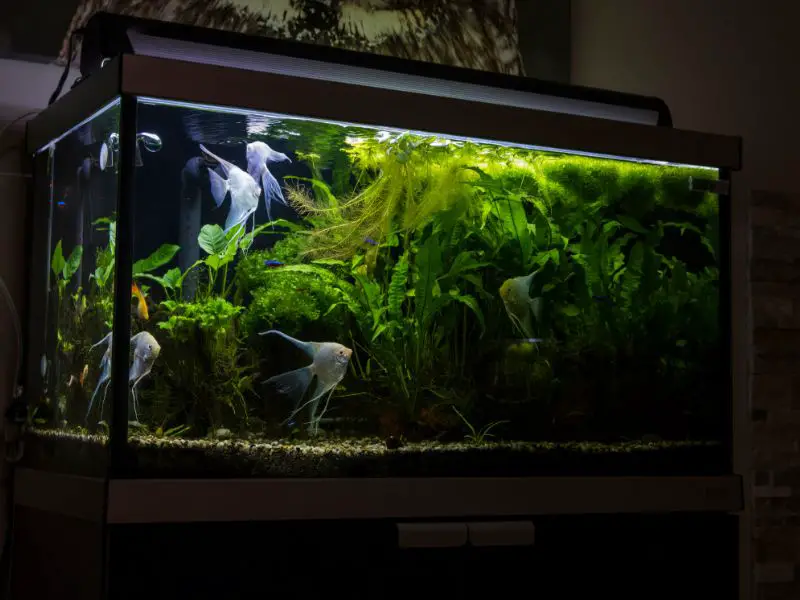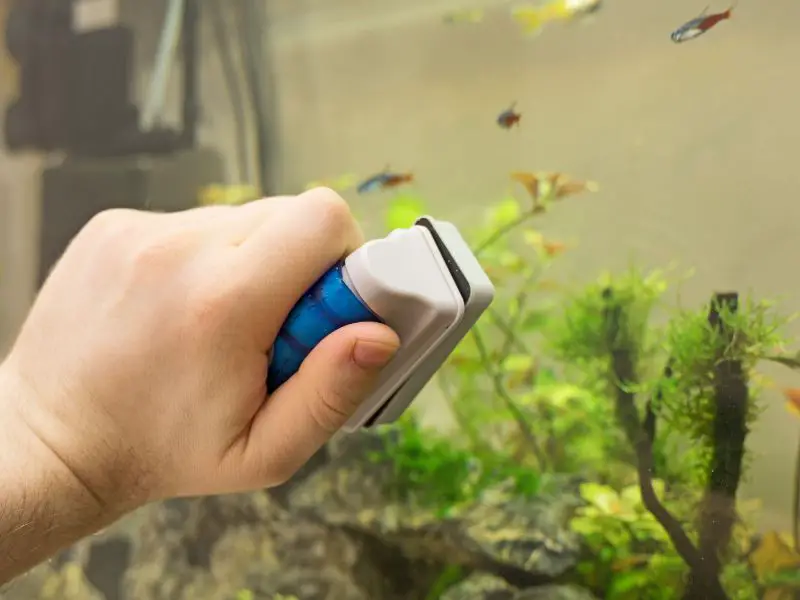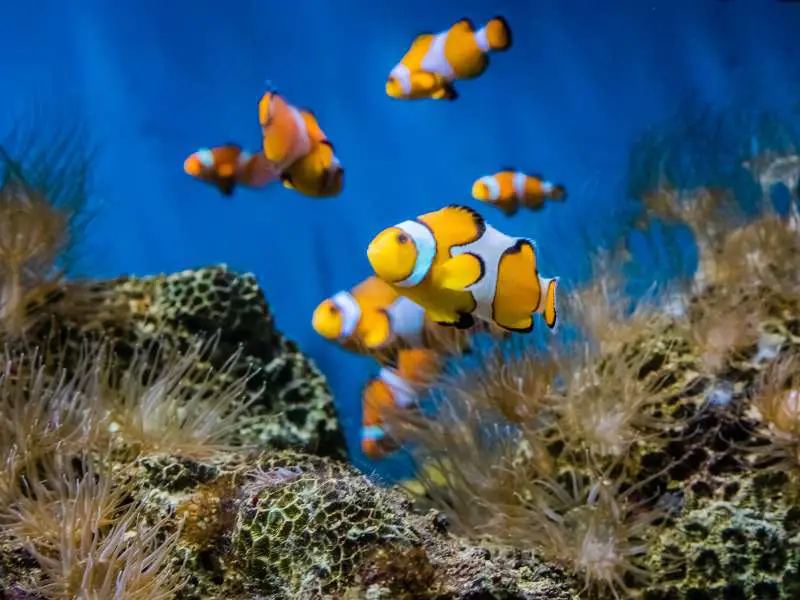Freshwater aquariums have long been popular among hobbyists due to their peaceful and lively aquatic environments. However, for those looking to take their aquarium hobby to new heights, the conversion from a freshwater tank to a saltwater setup presents an exciting opportunity. In this article, we will explore a step-by-step guide on how to convert a freshwater aquarium into a captivating saltwater paradise.

Understanding Freshwater Aquariums
Before diving into the conversion process, let’s briefly examine freshwater aquariums. These setups typically house fish, plants, and invertebrates that thrive in freshwater conditions. Freshwater aquariums are known for their ease of maintenance and require less equipment compared to saltwater tanks.
Benefits of Saltwater Aquariums
Saltwater aquariums offer a stunning display of vibrant colors, diverse marine life, and intricate ecosystems. Converting your freshwater aquarium to a saltwater setup opens the door to the fascinating world of coral reefs, exotic fish species, and captivating invertebrates. Saltwater aquariums are visually stunning and provide a rewarding experience for dedicated hobbyists.
Related: Top 10 Most Dangerous Fish in the World
Considerations Before Converting Freshwater Aquarium to Saltwater
Converting a freshwater aquarium to a saltwater setup requires careful planning and consideration. Here are a few important factors to keep in mind:
Research and Education
Before embarking on the conversion, it is crucial to conduct thorough research and educate yourself about the requirements of a saltwater aquarium. Familiarize yourself with different types of saltwater setups, necessary equipment, and the specific needs of the marine species you plan to keep.
Budget and Cost
Converting to a saltwater aquarium may involve higher expenses compared to maintaining a freshwater tank. Consider the cost of additional equipment such as protein skimmers, powerheads, and lighting systems. Additionally, saltwater fish and coral tend to be more expensive than their freshwater counterparts.
Time and Commitment
Saltwater aquariums generally require more time and effort to maintain than freshwater tanks. Regular testing of water parameters, maintaining stable salinity levels, and performing routine water changes are essential for the health and well-being of your saltwater ecosystem.

Steps to Convert Freshwater Aquarium to Saltwater
Now let’s explore the step-by-step process of converting your freshwater aquarium into a captivating saltwater paradise:
Step 1: Evaluate Your Current Setup
Begin by assessing the size and condition of your freshwater aquarium. Determine if it is suitable for accommodating a saltwater ecosystem or if you need to upgrade to a larger tank.
Step 2: Research and Plan
Conduct comprehensive research on the specific requirements of the marine species you wish to keep. Determine the ideal salinity levels, temperature range, and lighting needs. Create a detailed plan outlining the necessary equipment and modifications.
Step 3: Acquire Equipment and Supplies
Procure the required equipment for your saltwater setup, including a protein skimmer, lighting system, powerheads, and high-quality salt mix. Additionally, invest in a reliable water testing kit to monitor water parameters accurately.
Step 4: Prepare the Tank
Thoroughly clean your freshwater aquarium to remove any contaminants or residues. Replace the existing substrate with a marine-grade substrate suitable for saltwater tanks. Set up the necessary filtration system and install the lighting system.
Step 5: Introduce Saltwater
Gradually add pre-mixed saltwater to your tank, following the manufacturer’s instructions. Monitor salinity levels using a hydrometer or refractometer and make necessary adjustments. Allow the tank to stabilize for a few days before proceeding.
Step 6: Introduce Live Rock and Sand
Incorporate cured live rock into your aquarium to establish a biological filtration system. Live rock provides beneficial bacteria and creates a natural environment for marine life. Additionally, add live sand to facilitate the establishment of a healthy microbial community.
Step 7: Cycle the Tank
Allow the tank to go through the nitrogen cycle, which establishes a stable biological filtration system. Regularly monitor ammonia, nitrite, and nitrate levels, making necessary adjustments. This process typically takes a few weeks.
Step 8: Introduce Marine Life
Once your tank has completed the cycling process, gradually introduce marine life. Begin with hardy fish species and invertebrates, allowing your tank’s ecosystem to adjust to the new conditions. Properly acclimate new inhabitants to prevent stress or shock.
Step 9: Monitor and Maintain
Regularly test and monitor water parameters, including salinity, temperature, pH, and nutrient levels. Perform routine water changes to maintain water quality. Undertake regular maintenance tasks such as cleaning the glass, trimming corals, and replacing filter media.

Transitioning Fish and Plants
Transitioning fish and plants from a freshwater to a saltwater environment can be challenging. Some freshwater species may not be suitable for a saltwater environment, while others may require gradual acclimation. Consult experts or reputable sources to determine the compatibility and proper transitioning techniques for specific species.
Related: 10 Freshwater Sharks for Your Aquarium
Saltwater Aquarium Maintenance
Maintaining a saltwater aquarium demands consistent effort and attention to detail. Here are key aspects of saltwater aquarium maintenance:
Water Testing and Parameters
Regularly test and monitor water parameters, including salinity, temperature, pH, ammonia, nitrite, and nitrate levels. Keep records of these parameters and make adjustments as necessary.
Protein Skimming
Utilize a protein skimmer to remove organic compounds and dissolved organic matter from the water column. Protein skimmers play a crucial role in maintaining water clarity and reducing nutrient levels.
Water Changes
Perform regular water changes to replenish essential trace elements and maintain water quality. Aim for a water change schedule of 10-20% every two to four weeks, depending on your tank’s needs.
Algae Control
Prevent and manage excessive algae growth by maintaining appropriate nutrient levels, adhering to proper lighting duration, and introducing a natural cleanup crew comprising algae-eating organisms.
Equipment Maintenance
Regularly clean and maintain your aquarium equipment, including pumps, powerheads, filters, and lighting fixtures. Remove any accumulated debris or algae to ensure optimal performance.
Common Challenges when Converting Freshwater Aquariums to Saltwater
Converting a freshwater aquarium to a saltwater setup presents its fair share of challenges. Here are some common hurdles you might encounter:
Establishing Water Parameters
Maintaining stable water parameters can be challenging, particularly during the initial stages of setting up a saltwater aquarium. Proper testing and adjustments are crucial to create an environment suitable for marine life.
Algae Growth
Uncontrolled algae growth is a prevalent issue in saltwater aquariums. Diligently maintain nutrient levels, adhere to proper lighting schedules, and introduce an appropriate cleanup crew to mitigate this problem.
Compatibility Issues
Not all freshwater species are compatible with a saltwater environment. Research the specific requirements of the fish and invertebrates you plan to keep to ensure their compatibility with a saltwater setup.

Troubleshooting Tips
If you encounter any problems during the conversion or maintenance of your saltwater aquarium, here are some troubleshooting tips to help you address common issues:
Cloudy Water
Cloudiness in a saltwater aquarium can be caused by bacterial blooms, excess nutrients, or improper cycling. Test for high ammonia or nitrite levels, increase water circulation, and consider adding a fine mechanical filter pad to remove particles. Dilute excess nutrients through partial water changes and closely monitor the situation.
Algae Outbreak
In the event of an algae outbreak, check nutrient imbalances and lighting duration. Reduce the daily amount of light your tank receives, ensure proper protein skimming, and consider adding algae-eating organisms such as snails, crabs, or herbivorous fish.
Fish Compatibility Issues
If you notice aggression or compatibility issues among your fish, consider rearranging the tank layout to provide hiding spots and territories. If the problem persists, separate aggressive individuals or seek advice from an aquarium specialist.
Coral Bleaching
Coral bleaching can occur due to stress or unfavorable water conditions. Ensure stable water parameters, proper lighting, and appropriate nutrient levels. If coral bleaching persists, you may need to relocate affected corals to a different area or seek guidance from an expert.
Ammonia or Nitrite Spikes
If you observe spikes in ammonia or nitrite levels, it could indicate an imbalance in the biological filtration system. Conduct water tests to identify the cause. Increase aeration, reduce feeding, and consider using beneficial bacteria supplements to help establish a healthy nitrogen cycle.
Related: How Much Does it Cost to Pet a Shark?
Conclusion
Converting a freshwater aquarium into a saltwater setup is an exciting endeavor that can transform your hobby into a captivating experience. By following the step-by-step process, conducting thorough research, and dedicating time to proper care and maintenance, you can successfully create a stunning saltwater ecosystem. Remember to monitor water parameters diligently, provide suitable habitats for your fish and corals, and address any challenges that arise. With patience, knowledge, and dedication, you can enjoy the beauty and diversity of a saltwater aquarium for years to come.
FAQs ( Frequently Asked Questions )
Yes, you can convert your freshwater tank to a saltwater tank. However, it requires careful planning, research, and adjustments to ensure a successful transition. Considerations such as equipment, budget, time commitment, and the specific needs of saltwater species must be taken into account. By following the proper steps and providing the necessary care and maintenance, you can create a thriving saltwater ecosystem in your converted tank.
Yes, it is possible to switch from a freshwater aquarium to a saltwater aquarium. However, it requires careful planning, acquiring the right equipment, and adjusting the tank setup to accommodate the specific needs of saltwater species. With proper research and preparation, you can successfully make the switch and create a thriving saltwater ecosystem in your aquarium.
In general, most freshwater fish cannot be converted to a saltwater environment due to their inability to tolerate high salinity levels. Saltwater fish have specific physiological adaptations that enable them to live in saltwater conditions. It is recommended to choose saltwater fish species that are naturally suited for a saltwater aquarium rather than attempting to convert freshwater fish, as they have different requirements and tolerances. Proper research and selection of saltwater species will ensure a successful and thriving saltwater aquarium.
